Dissertation on Self-Healing Concrete: Future Prospects
VerifiedAdded on 2020/07/22
|62
|17583
|394
Thesis and Dissertation
AI Summary
This dissertation provides a comprehensive analysis of self-healing concrete (SHC), exploring its potential as a construction material and its impact on reducing long-term maintenance costs. The research begins with an evaluation of SHC's significance in the construction industry, followed by a detailed examination of various approaches and mechanisms, including biological, vascular, and chemical methods. A cost-benefit analysis is presented, highlighting the economic and environmental advantages of SHC compared to traditional concrete. The study incorporates extensive secondary research, including a critical evaluation of published literature and case studies of SHC applications. The findings reveal that SHC, particularly biological SHC, offers enhanced durability and sustainability by restricting the entry of foreign substances and reducing CO2 emissions. While the initial production cost of SHC may be higher, the long-term reduction in maintenance costs makes it a cost-effective solution. The dissertation also addresses the current limitations and future prospects of SHC, emphasizing the need for further research to optimize its performance under different environmental conditions.
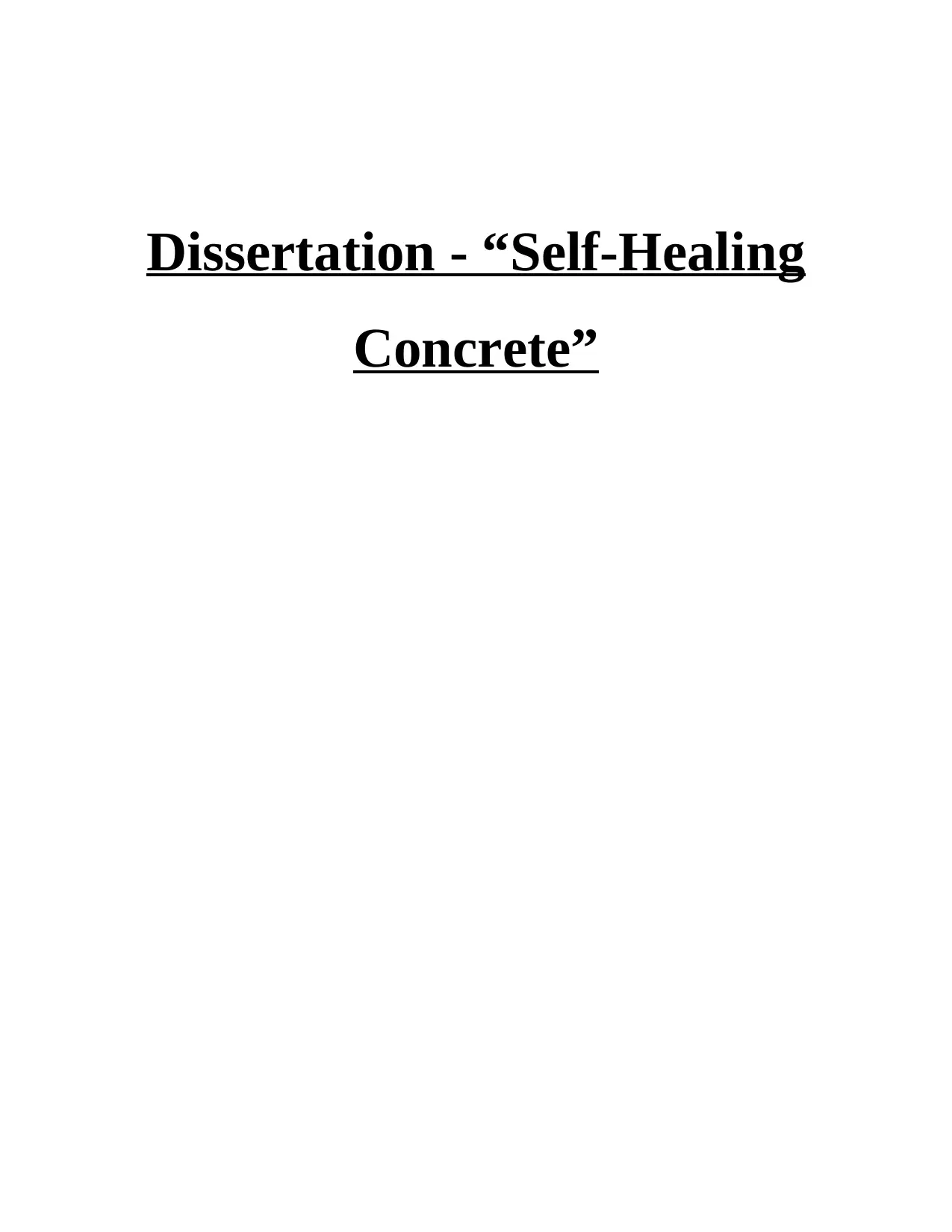
Dissertation - “Self-Healing
Concrete”
Concrete”
Paraphrase This Document
Need a fresh take? Get an instant paraphrase of this document with our AI Paraphraser
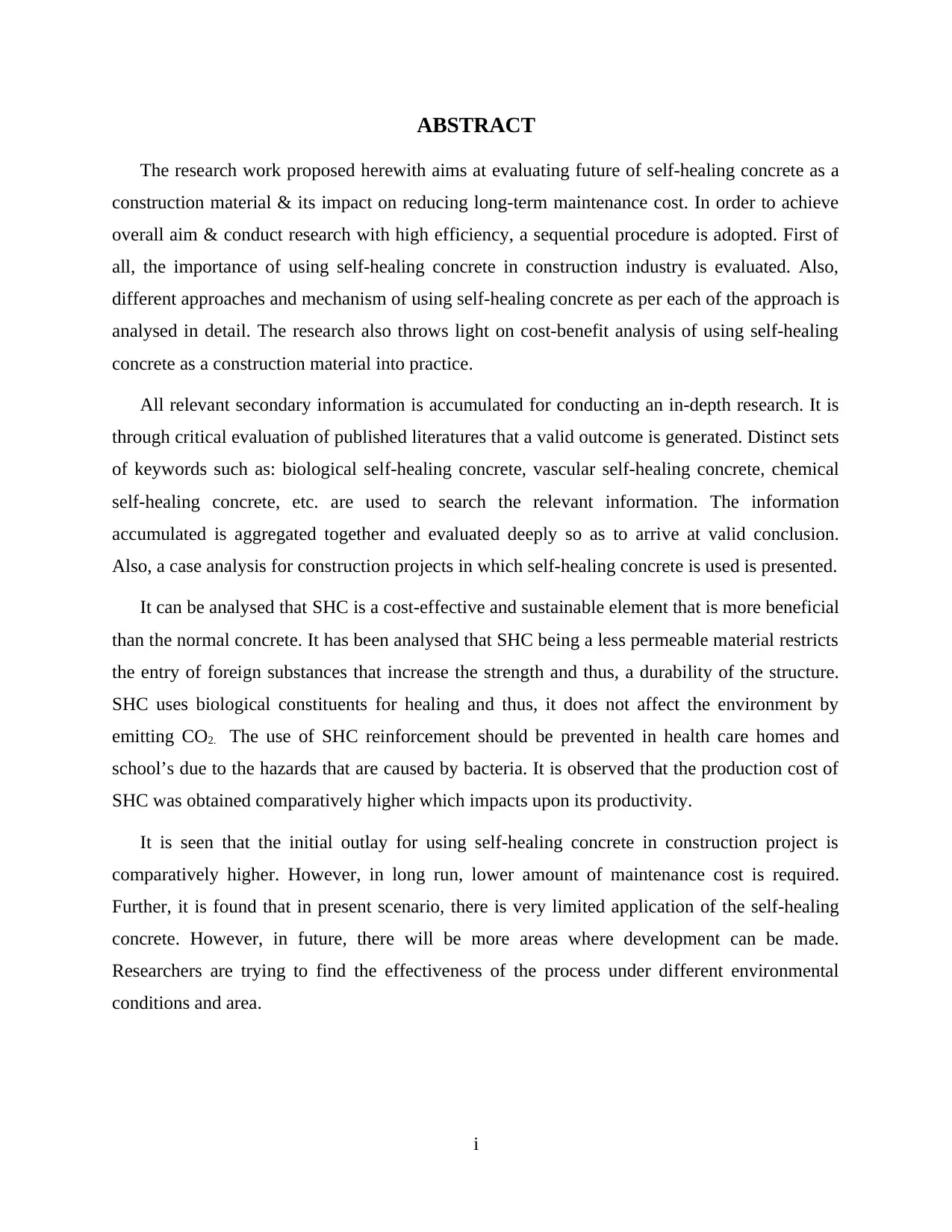
ABSTRACT
The research work proposed herewith aims at evaluating future of self-healing concrete as a
construction material & its impact on reducing long-term maintenance cost. In order to achieve
overall aim & conduct research with high efficiency, a sequential procedure is adopted. First of
all, the importance of using self-healing concrete in construction industry is evaluated. Also,
different approaches and mechanism of using self-healing concrete as per each of the approach is
analysed in detail. The research also throws light on cost-benefit analysis of using self-healing
concrete as a construction material into practice.
All relevant secondary information is accumulated for conducting an in-depth research. It is
through critical evaluation of published literatures that a valid outcome is generated. Distinct sets
of keywords such as: biological self-healing concrete, vascular self-healing concrete, chemical
self-healing concrete, etc. are used to search the relevant information. The information
accumulated is aggregated together and evaluated deeply so as to arrive at valid conclusion.
Also, a case analysis for construction projects in which self-healing concrete is used is presented.
It can be analysed that SHC is a cost-effective and sustainable element that is more beneficial
than the normal concrete. It has been analysed that SHC being a less permeable material restricts
the entry of foreign substances that increase the strength and thus, a durability of the structure.
SHC uses biological constituents for healing and thus, it does not affect the environment by
emitting CO2. The use of SHC reinforcement should be prevented in health care homes and
school’s due to the hazards that are caused by bacteria. It is observed that the production cost of
SHC was obtained comparatively higher which impacts upon its productivity.
It is seen that the initial outlay for using self-healing concrete in construction project is
comparatively higher. However, in long run, lower amount of maintenance cost is required.
Further, it is found that in present scenario, there is very limited application of the self-healing
concrete. However, in future, there will be more areas where development can be made.
Researchers are trying to find the effectiveness of the process under different environmental
conditions and area.
i
The research work proposed herewith aims at evaluating future of self-healing concrete as a
construction material & its impact on reducing long-term maintenance cost. In order to achieve
overall aim & conduct research with high efficiency, a sequential procedure is adopted. First of
all, the importance of using self-healing concrete in construction industry is evaluated. Also,
different approaches and mechanism of using self-healing concrete as per each of the approach is
analysed in detail. The research also throws light on cost-benefit analysis of using self-healing
concrete as a construction material into practice.
All relevant secondary information is accumulated for conducting an in-depth research. It is
through critical evaluation of published literatures that a valid outcome is generated. Distinct sets
of keywords such as: biological self-healing concrete, vascular self-healing concrete, chemical
self-healing concrete, etc. are used to search the relevant information. The information
accumulated is aggregated together and evaluated deeply so as to arrive at valid conclusion.
Also, a case analysis for construction projects in which self-healing concrete is used is presented.
It can be analysed that SHC is a cost-effective and sustainable element that is more beneficial
than the normal concrete. It has been analysed that SHC being a less permeable material restricts
the entry of foreign substances that increase the strength and thus, a durability of the structure.
SHC uses biological constituents for healing and thus, it does not affect the environment by
emitting CO2. The use of SHC reinforcement should be prevented in health care homes and
school’s due to the hazards that are caused by bacteria. It is observed that the production cost of
SHC was obtained comparatively higher which impacts upon its productivity.
It is seen that the initial outlay for using self-healing concrete in construction project is
comparatively higher. However, in long run, lower amount of maintenance cost is required.
Further, it is found that in present scenario, there is very limited application of the self-healing
concrete. However, in future, there will be more areas where development can be made.
Researchers are trying to find the effectiveness of the process under different environmental
conditions and area.
i
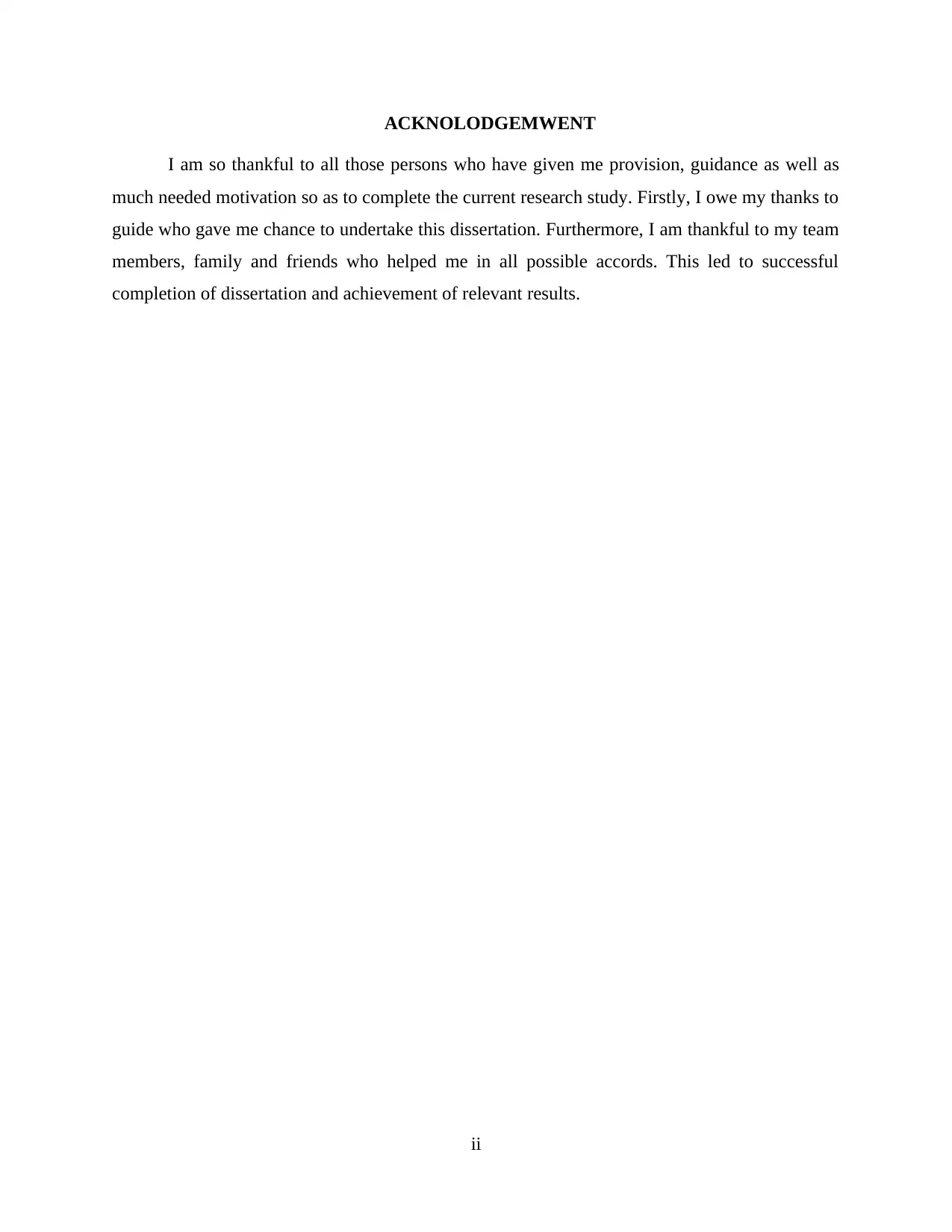
ACKNOLODGEMWENT
I am so thankful to all those persons who have given me provision, guidance as well as
much needed motivation so as to complete the current research study. Firstly, I owe my thanks to
guide who gave me chance to undertake this dissertation. Furthermore, I am thankful to my team
members, family and friends who helped me in all possible accords. This led to successful
completion of dissertation and achievement of relevant results.
ii
I am so thankful to all those persons who have given me provision, guidance as well as
much needed motivation so as to complete the current research study. Firstly, I owe my thanks to
guide who gave me chance to undertake this dissertation. Furthermore, I am thankful to my team
members, family and friends who helped me in all possible accords. This led to successful
completion of dissertation and achievement of relevant results.
ii
⊘ This is a preview!⊘
Do you want full access?
Subscribe today to unlock all pages.

Trusted by 1+ million students worldwide
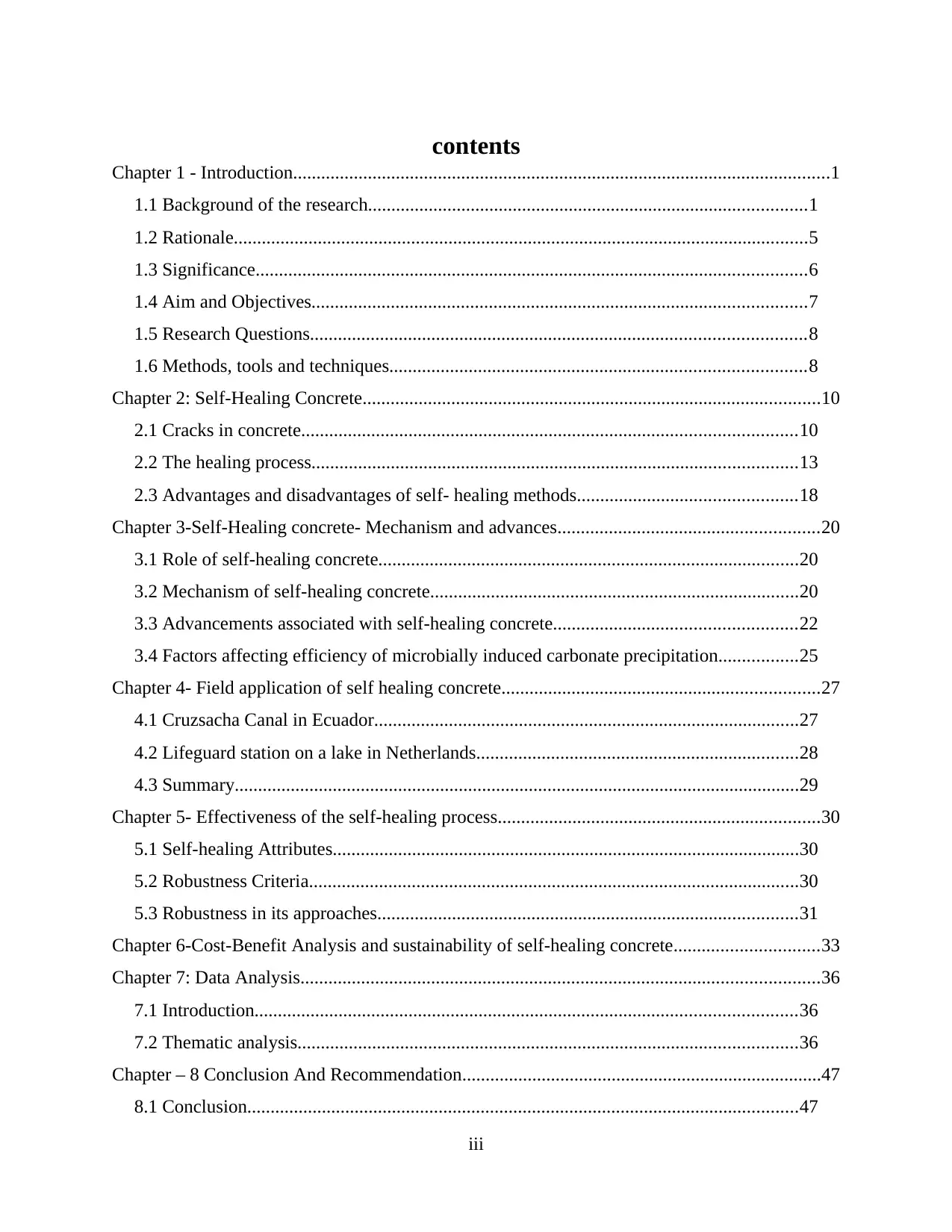
contents
Chapter 1 - Introduction...................................................................................................................1
1.1 Background of the research..............................................................................................1
1.2 Rationale...........................................................................................................................5
1.3 Significance......................................................................................................................6
1.4 Aim and Objectives..........................................................................................................7
1.5 Research Questions..........................................................................................................8
1.6 Methods, tools and techniques.........................................................................................8
Chapter 2: Self-Healing Concrete..................................................................................................10
2.1 Cracks in concrete..........................................................................................................10
2.2 The healing process........................................................................................................13
2.3 Advantages and disadvantages of self- healing methods...............................................18
Chapter 3-Self-Healing concrete- Mechanism and advances........................................................20
3.1 Role of self-healing concrete..........................................................................................20
3.2 Mechanism of self-healing concrete...............................................................................20
3.3 Advancements associated with self-healing concrete....................................................22
3.4 Factors affecting efficiency of microbially induced carbonate precipitation.................25
Chapter 4- Field application of self healing concrete....................................................................27
4.1 Cruzsacha Canal in Ecuador...........................................................................................27
4.2 Lifeguard station on a lake in Netherlands.....................................................................28
4.3 Summary.........................................................................................................................29
Chapter 5- Effectiveness of the self-healing process.....................................................................30
5.1 Self-healing Attributes....................................................................................................30
5.2 Robustness Criteria.........................................................................................................30
5.3 Robustness in its approaches..........................................................................................31
Chapter 6-Cost-Benefit Analysis and sustainability of self-healing concrete...............................33
Chapter 7: Data Analysis...............................................................................................................36
7.1 Introduction....................................................................................................................36
7.2 Thematic analysis...........................................................................................................36
Chapter – 8 Conclusion And Recommendation.............................................................................47
8.1 Conclusion......................................................................................................................47
iii
Chapter 1 - Introduction...................................................................................................................1
1.1 Background of the research..............................................................................................1
1.2 Rationale...........................................................................................................................5
1.3 Significance......................................................................................................................6
1.4 Aim and Objectives..........................................................................................................7
1.5 Research Questions..........................................................................................................8
1.6 Methods, tools and techniques.........................................................................................8
Chapter 2: Self-Healing Concrete..................................................................................................10
2.1 Cracks in concrete..........................................................................................................10
2.2 The healing process........................................................................................................13
2.3 Advantages and disadvantages of self- healing methods...............................................18
Chapter 3-Self-Healing concrete- Mechanism and advances........................................................20
3.1 Role of self-healing concrete..........................................................................................20
3.2 Mechanism of self-healing concrete...............................................................................20
3.3 Advancements associated with self-healing concrete....................................................22
3.4 Factors affecting efficiency of microbially induced carbonate precipitation.................25
Chapter 4- Field application of self healing concrete....................................................................27
4.1 Cruzsacha Canal in Ecuador...........................................................................................27
4.2 Lifeguard station on a lake in Netherlands.....................................................................28
4.3 Summary.........................................................................................................................29
Chapter 5- Effectiveness of the self-healing process.....................................................................30
5.1 Self-healing Attributes....................................................................................................30
5.2 Robustness Criteria.........................................................................................................30
5.3 Robustness in its approaches..........................................................................................31
Chapter 6-Cost-Benefit Analysis and sustainability of self-healing concrete...............................33
Chapter 7: Data Analysis...............................................................................................................36
7.1 Introduction....................................................................................................................36
7.2 Thematic analysis...........................................................................................................36
Chapter – 8 Conclusion And Recommendation.............................................................................47
8.1 Conclusion......................................................................................................................47
iii
Paraphrase This Document
Need a fresh take? Get an instant paraphrase of this document with our AI Paraphraser
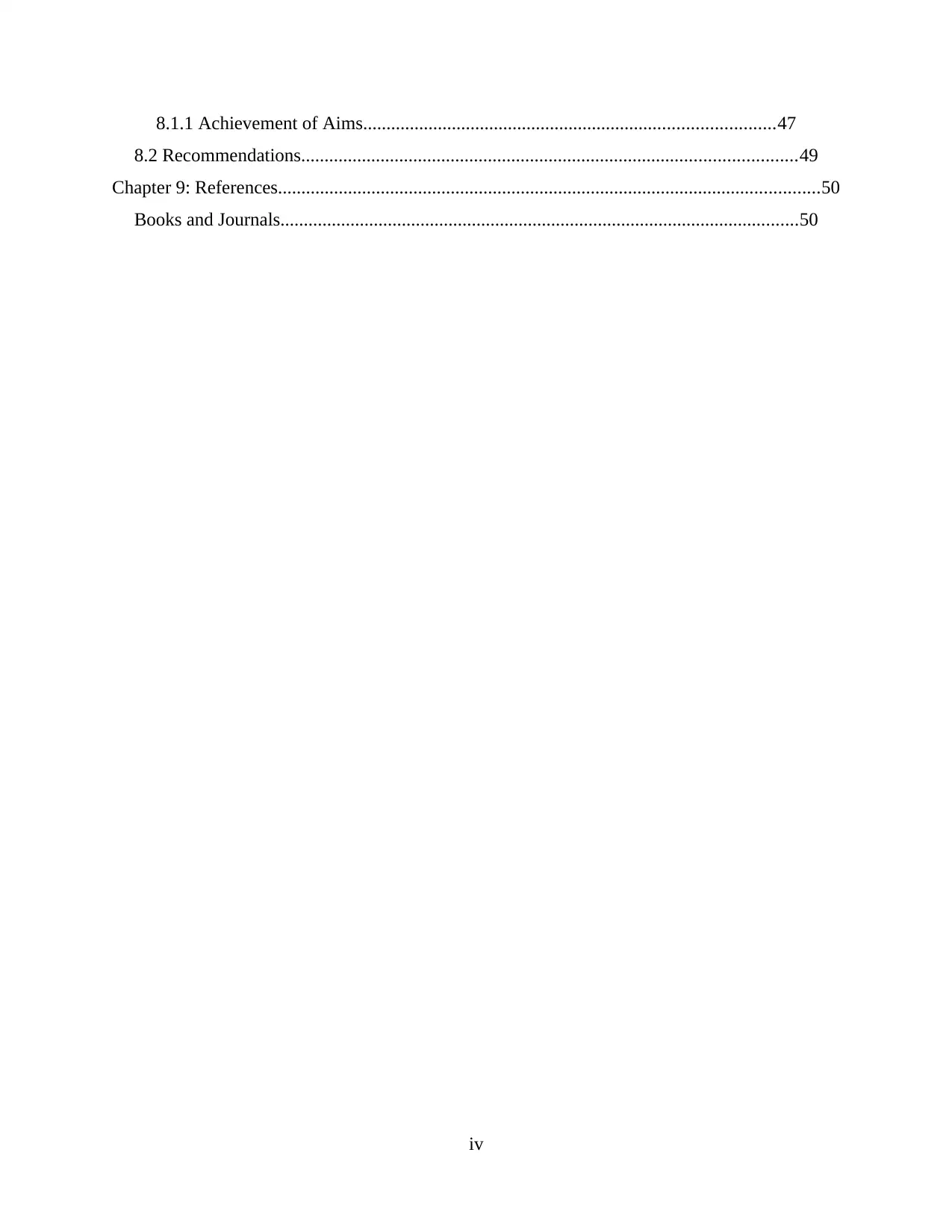
8.1.1 Achievement of Aims........................................................................................47
8.2 Recommendations..........................................................................................................49
Chapter 9: References....................................................................................................................50
Books and Journals...............................................................................................................50
iv
8.2 Recommendations..........................................................................................................49
Chapter 9: References....................................................................................................................50
Books and Journals...............................................................................................................50
iv
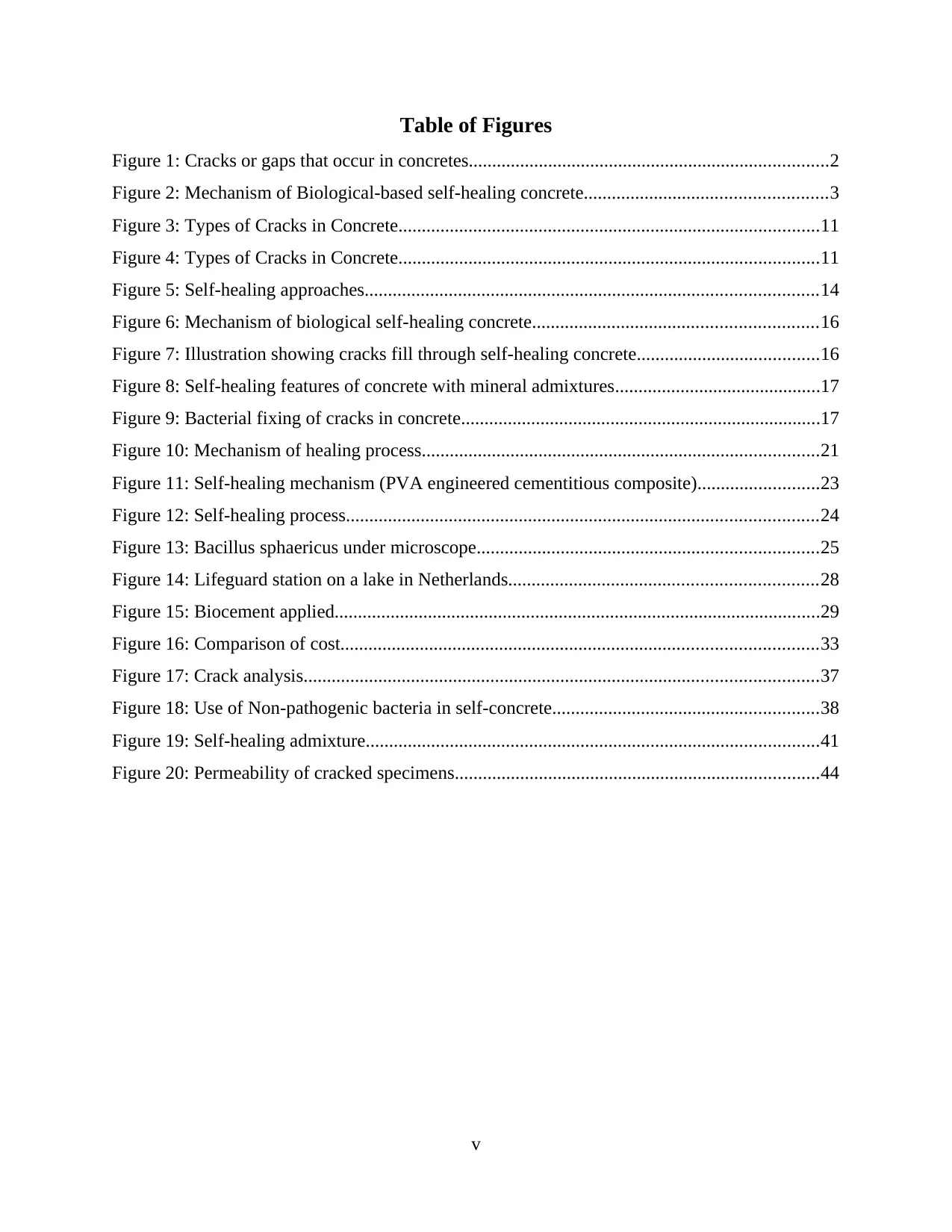
Table of Figures
Figure 1: Cracks or gaps that occur in concretes.............................................................................2
Figure 2: Mechanism of Biological-based self-healing concrete....................................................3
Figure 3: Types of Cracks in Concrete..........................................................................................11
Figure 4: Types of Cracks in Concrete..........................................................................................11
Figure 5: Self-healing approaches.................................................................................................14
Figure 6: Mechanism of biological self-healing concrete.............................................................16
Figure 7: Illustration showing cracks fill through self-healing concrete.......................................16
Figure 8: Self-healing features of concrete with mineral admixtures............................................17
Figure 9: Bacterial fixing of cracks in concrete.............................................................................17
Figure 10: Mechanism of healing process.....................................................................................21
Figure 11: Self-healing mechanism (PVA engineered cementitious composite)..........................23
Figure 12: Self-healing process.....................................................................................................24
Figure 13: Bacillus sphaericus under microscope.........................................................................25
Figure 14: Lifeguard station on a lake in Netherlands..................................................................28
Figure 15: Biocement applied........................................................................................................29
Figure 16: Comparison of cost......................................................................................................33
Figure 17: Crack analysis..............................................................................................................37
Figure 18: Use of Non-pathogenic bacteria in self-concrete.........................................................38
Figure 19: Self-healing admixture.................................................................................................41
Figure 20: Permeability of cracked specimens..............................................................................44
v
Figure 1: Cracks or gaps that occur in concretes.............................................................................2
Figure 2: Mechanism of Biological-based self-healing concrete....................................................3
Figure 3: Types of Cracks in Concrete..........................................................................................11
Figure 4: Types of Cracks in Concrete..........................................................................................11
Figure 5: Self-healing approaches.................................................................................................14
Figure 6: Mechanism of biological self-healing concrete.............................................................16
Figure 7: Illustration showing cracks fill through self-healing concrete.......................................16
Figure 8: Self-healing features of concrete with mineral admixtures............................................17
Figure 9: Bacterial fixing of cracks in concrete.............................................................................17
Figure 10: Mechanism of healing process.....................................................................................21
Figure 11: Self-healing mechanism (PVA engineered cementitious composite)..........................23
Figure 12: Self-healing process.....................................................................................................24
Figure 13: Bacillus sphaericus under microscope.........................................................................25
Figure 14: Lifeguard station on a lake in Netherlands..................................................................28
Figure 15: Biocement applied........................................................................................................29
Figure 16: Comparison of cost......................................................................................................33
Figure 17: Crack analysis..............................................................................................................37
Figure 18: Use of Non-pathogenic bacteria in self-concrete.........................................................38
Figure 19: Self-healing admixture.................................................................................................41
Figure 20: Permeability of cracked specimens..............................................................................44
v
⊘ This is a preview!⊘
Do you want full access?
Subscribe today to unlock all pages.

Trusted by 1+ million students worldwide
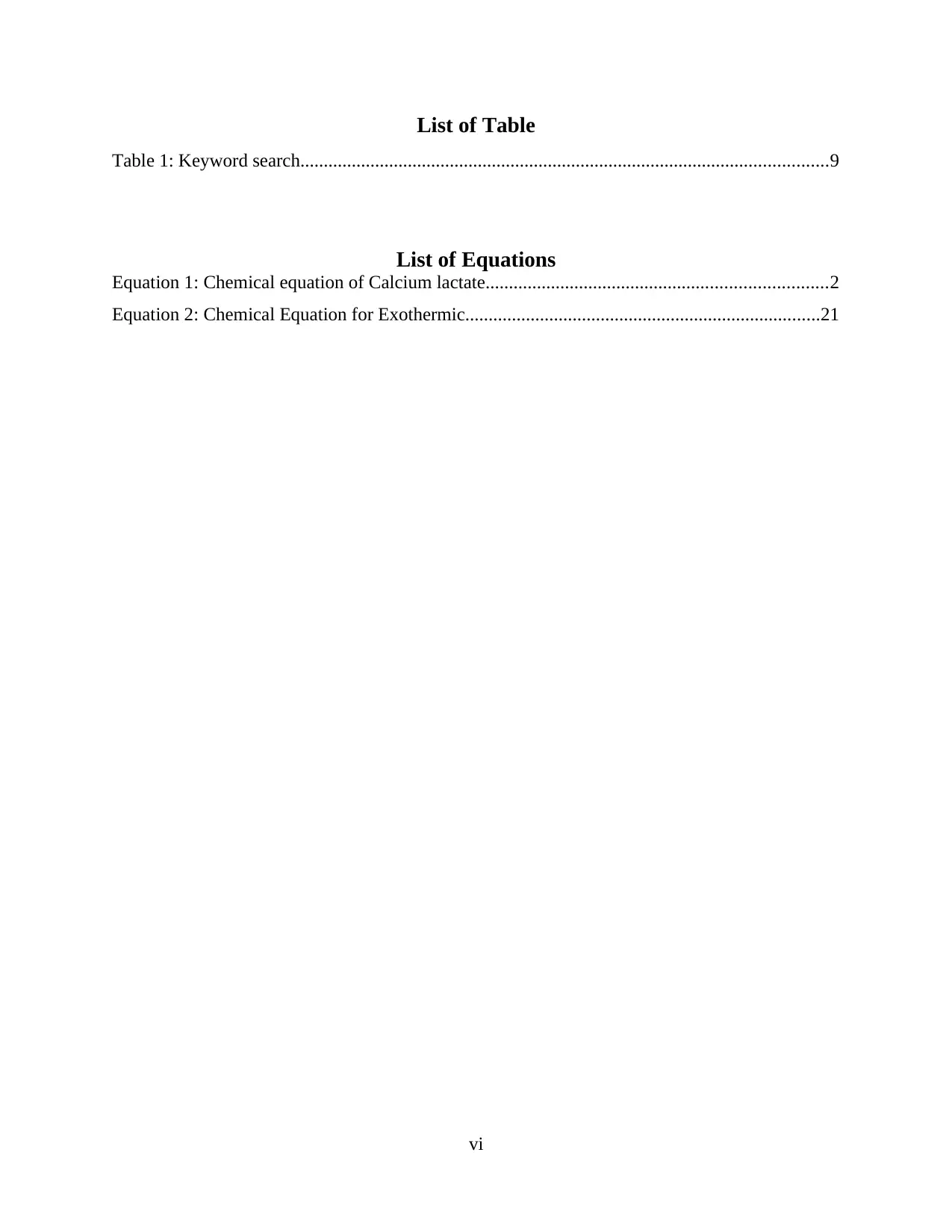
List of Table
Table 1: Keyword search.................................................................................................................9
List of Equations
Equation 1: Chemical equation of Calcium lactate.........................................................................2
Equation 2: Chemical Equation for Exothermic............................................................................21
vi
Table 1: Keyword search.................................................................................................................9
List of Equations
Equation 1: Chemical equation of Calcium lactate.........................................................................2
Equation 2: Chemical Equation for Exothermic............................................................................21
vi
Paraphrase This Document
Need a fresh take? Get an instant paraphrase of this document with our AI Paraphraser
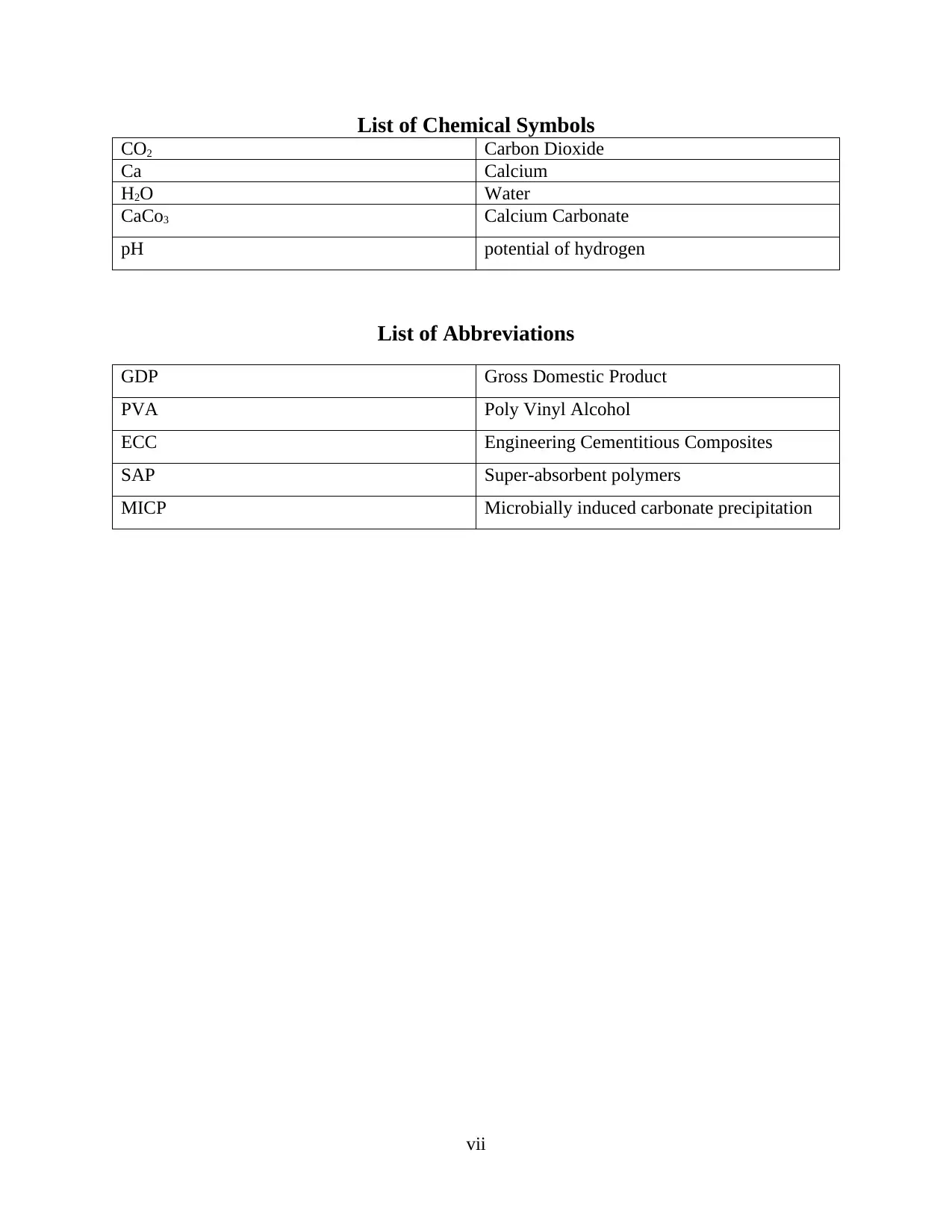
List of Chemical Symbols
CO2 Carbon Dioxide
Ca Calcium
H2O Water
CaCo3 Calcium Carbonate
pH potential of hydrogen
List of Abbreviations
GDP Gross Domestic Product
PVA Poly Vinyl Alcohol
ECC Engineering Cementitious Composites
SAP Super-absorbent polymers
MICP Microbially induced carbonate precipitation
vii
CO2 Carbon Dioxide
Ca Calcium
H2O Water
CaCo3 Calcium Carbonate
pH potential of hydrogen
List of Abbreviations
GDP Gross Domestic Product
PVA Poly Vinyl Alcohol
ECC Engineering Cementitious Composites
SAP Super-absorbent polymers
MICP Microbially induced carbonate precipitation
vii
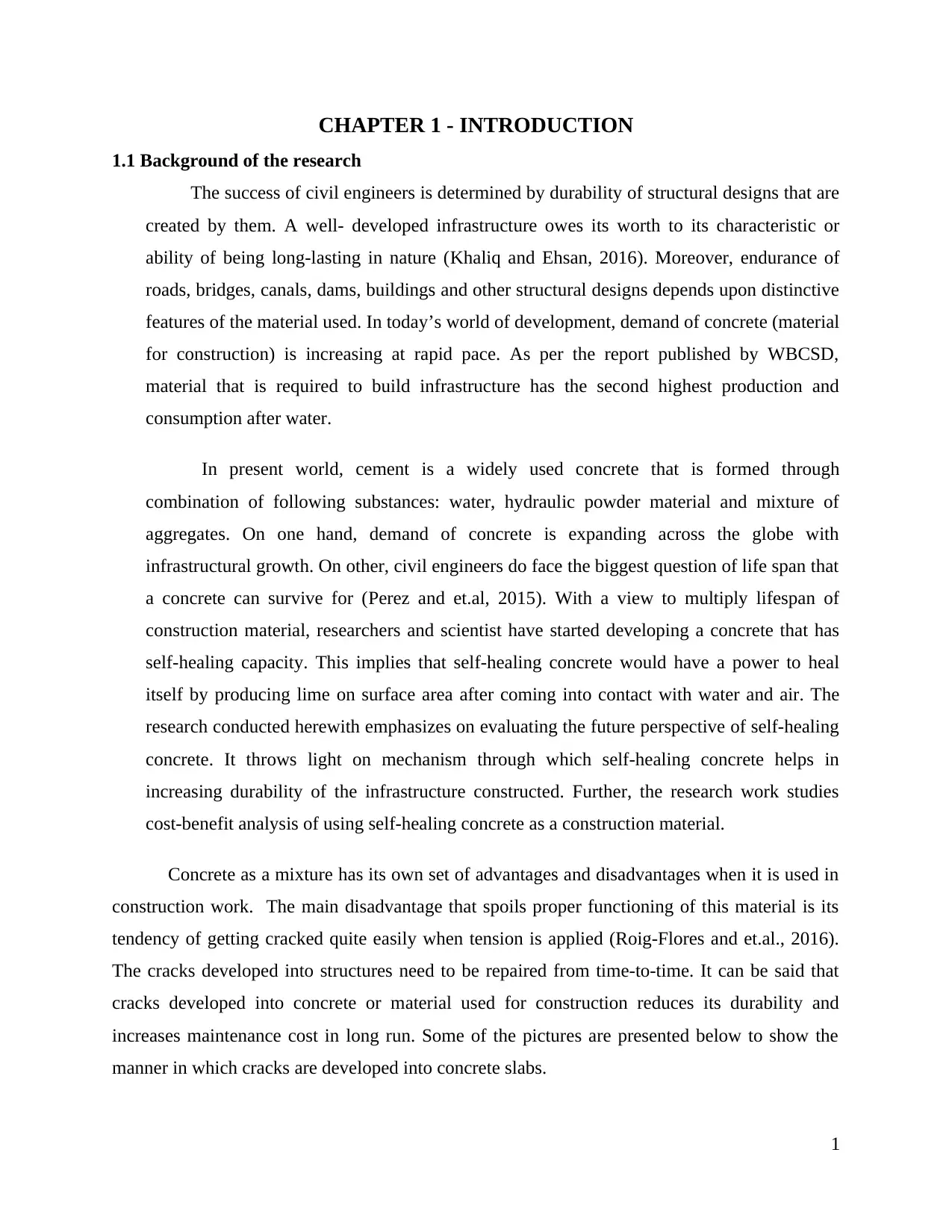
CHAPTER 1 - INTRODUCTION
1.1 Background of the research
The success of civil engineers is determined by durability of structural designs that are
created by them. A well- developed infrastructure owes its worth to its characteristic or
ability of being long-lasting in nature (Khaliq and Ehsan, 2016). Moreover, endurance of
roads, bridges, canals, dams, buildings and other structural designs depends upon distinctive
features of the material used. In today’s world of development, demand of concrete (material
for construction) is increasing at rapid pace. As per the report published by WBCSD,
material that is required to build infrastructure has the second highest production and
consumption after water.
In present world, cement is a widely used concrete that is formed through
combination of following substances: water, hydraulic powder material and mixture of
aggregates. On one hand, demand of concrete is expanding across the globe with
infrastructural growth. On other, civil engineers do face the biggest question of life span that
a concrete can survive for (Perez and et.al, 2015). With a view to multiply lifespan of
construction material, researchers and scientist have started developing a concrete that has
self-healing capacity. This implies that self-healing concrete would have a power to heal
itself by producing lime on surface area after coming into contact with water and air. The
research conducted herewith emphasizes on evaluating the future perspective of self-healing
concrete. It throws light on mechanism through which self-healing concrete helps in
increasing durability of the infrastructure constructed. Further, the research work studies
cost-benefit analysis of using self-healing concrete as a construction material.
Concrete as a mixture has its own set of advantages and disadvantages when it is used in
construction work. The main disadvantage that spoils proper functioning of this material is its
tendency of getting cracked quite easily when tension is applied (Roig-Flores and et.al., 2016).
The cracks developed into structures need to be repaired from time-to-time. It can be said that
cracks developed into concrete or material used for construction reduces its durability and
increases maintenance cost in long run. Some of the pictures are presented below to show the
manner in which cracks are developed into concrete slabs.
1
1.1 Background of the research
The success of civil engineers is determined by durability of structural designs that are
created by them. A well- developed infrastructure owes its worth to its characteristic or
ability of being long-lasting in nature (Khaliq and Ehsan, 2016). Moreover, endurance of
roads, bridges, canals, dams, buildings and other structural designs depends upon distinctive
features of the material used. In today’s world of development, demand of concrete (material
for construction) is increasing at rapid pace. As per the report published by WBCSD,
material that is required to build infrastructure has the second highest production and
consumption after water.
In present world, cement is a widely used concrete that is formed through
combination of following substances: water, hydraulic powder material and mixture of
aggregates. On one hand, demand of concrete is expanding across the globe with
infrastructural growth. On other, civil engineers do face the biggest question of life span that
a concrete can survive for (Perez and et.al, 2015). With a view to multiply lifespan of
construction material, researchers and scientist have started developing a concrete that has
self-healing capacity. This implies that self-healing concrete would have a power to heal
itself by producing lime on surface area after coming into contact with water and air. The
research conducted herewith emphasizes on evaluating the future perspective of self-healing
concrete. It throws light on mechanism through which self-healing concrete helps in
increasing durability of the infrastructure constructed. Further, the research work studies
cost-benefit analysis of using self-healing concrete as a construction material.
Concrete as a mixture has its own set of advantages and disadvantages when it is used in
construction work. The main disadvantage that spoils proper functioning of this material is its
tendency of getting cracked quite easily when tension is applied (Roig-Flores and et.al., 2016).
The cracks developed into structures need to be repaired from time-to-time. It can be said that
cracks developed into concrete or material used for construction reduces its durability and
increases maintenance cost in long run. Some of the pictures are presented below to show the
manner in which cracks are developed into concrete slabs.
1
⊘ This is a preview!⊘
Do you want full access?
Subscribe today to unlock all pages.

Trusted by 1+ million students worldwide
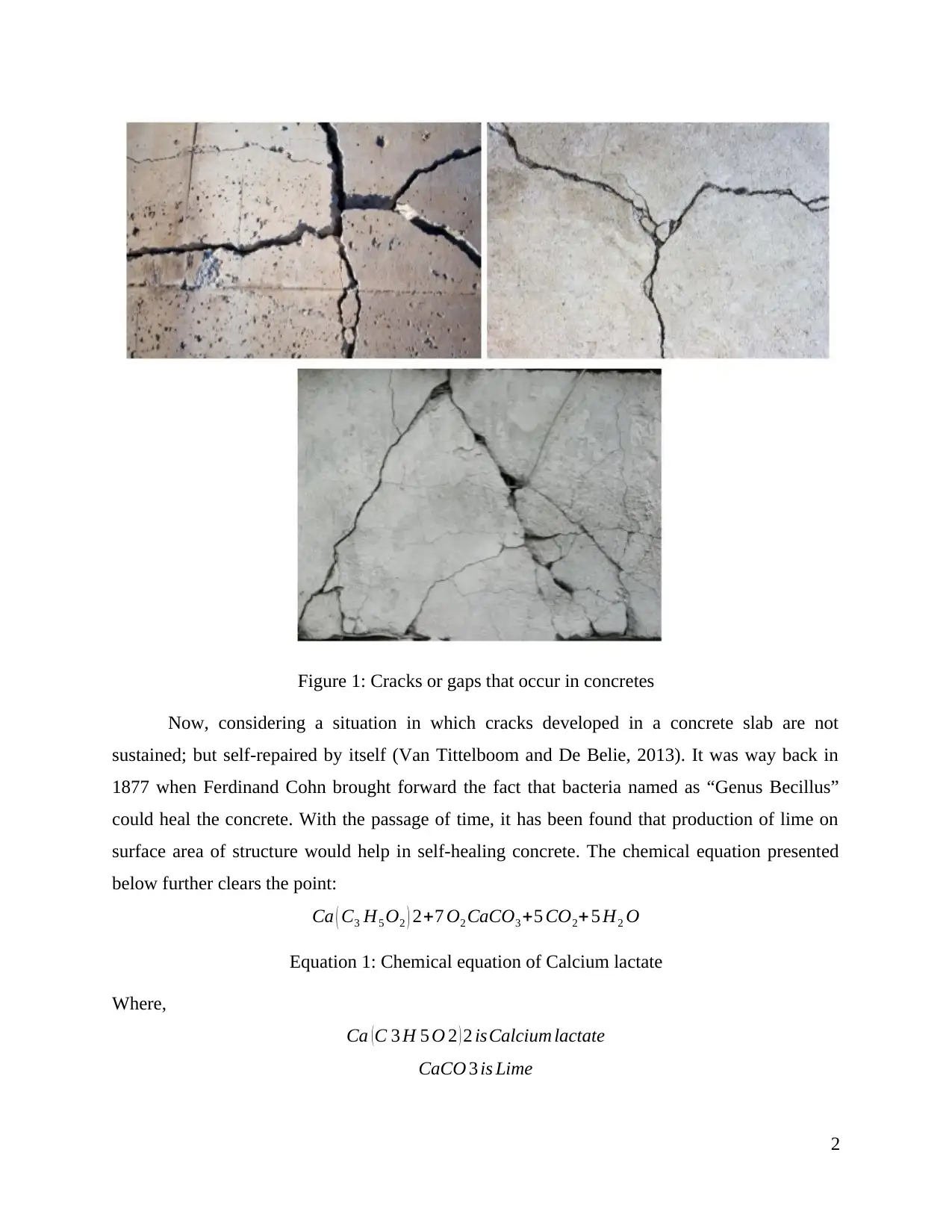
Figure 1: Cracks or gaps that occur in concretes
Now, considering a situation in which cracks developed in a concrete slab are not
sustained; but self-repaired by itself (Van Tittelboom and De Belie, 2013). It was way back in
1877 when Ferdinand Cohn brought forward the fact that bacteria named as “Genus Becillus”
could heal the concrete. With the passage of time, it has been found that production of lime on
surface area of structure would help in self-healing concrete. The chemical equation presented
below further clears the point:
Ca ( C3 H5 O2 ) 2+7 O2 CaCO3 +5 CO2+ 5 H2 O
Equation 1: Chemical equation of Calcium lactate
Where,
Ca (C 3 H 5 O 2 ) 2 isCalcium lactate
CaCO 3 is Lime
2
Now, considering a situation in which cracks developed in a concrete slab are not
sustained; but self-repaired by itself (Van Tittelboom and De Belie, 2013). It was way back in
1877 when Ferdinand Cohn brought forward the fact that bacteria named as “Genus Becillus”
could heal the concrete. With the passage of time, it has been found that production of lime on
surface area of structure would help in self-healing concrete. The chemical equation presented
below further clears the point:
Ca ( C3 H5 O2 ) 2+7 O2 CaCO3 +5 CO2+ 5 H2 O
Equation 1: Chemical equation of Calcium lactate
Where,
Ca (C 3 H 5 O 2 ) 2 isCalcium lactate
CaCO 3 is Lime
2
Paraphrase This Document
Need a fresh take? Get an instant paraphrase of this document with our AI Paraphraser
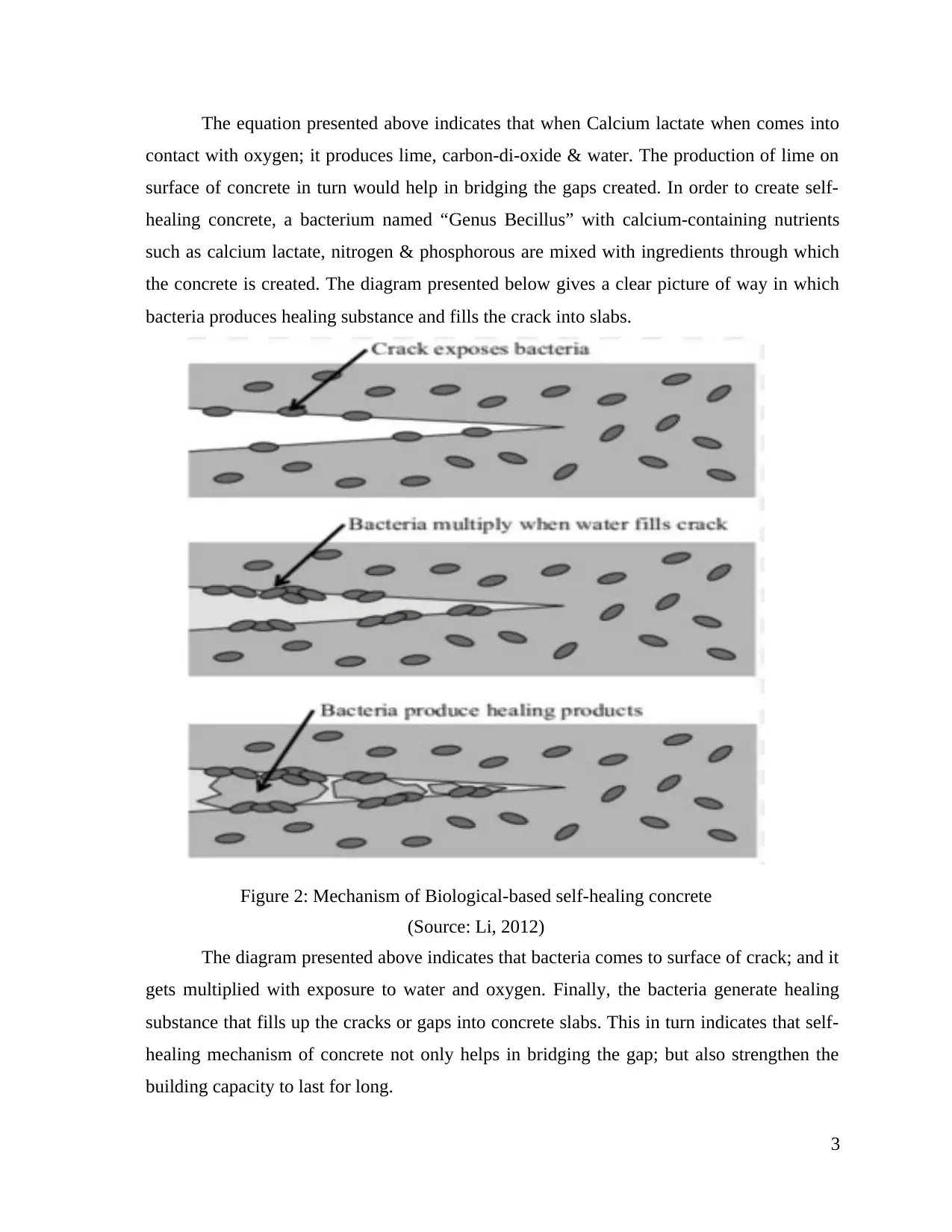
The equation presented above indicates that when Calcium lactate when comes into
contact with oxygen; it produces lime, carbon-di-oxide & water. The production of lime on
surface of concrete in turn would help in bridging the gaps created. In order to create self-
healing concrete, a bacterium named “Genus Becillus” with calcium-containing nutrients
such as calcium lactate, nitrogen & phosphorous are mixed with ingredients through which
the concrete is created. The diagram presented below gives a clear picture of way in which
bacteria produces healing substance and fills the crack into slabs.
Figure 2: Mechanism of Biological-based self-healing concrete
(Source: Li, 2012)
The diagram presented above indicates that bacteria comes to surface of crack; and it
gets multiplied with exposure to water and oxygen. Finally, the bacteria generate healing
substance that fills up the cracks or gaps into concrete slabs. This in turn indicates that self-
healing mechanism of concrete not only helps in bridging the gap; but also strengthen the
building capacity to last for long.
3
contact with oxygen; it produces lime, carbon-di-oxide & water. The production of lime on
surface of concrete in turn would help in bridging the gaps created. In order to create self-
healing concrete, a bacterium named “Genus Becillus” with calcium-containing nutrients
such as calcium lactate, nitrogen & phosphorous are mixed with ingredients through which
the concrete is created. The diagram presented below gives a clear picture of way in which
bacteria produces healing substance and fills the crack into slabs.
Figure 2: Mechanism of Biological-based self-healing concrete
(Source: Li, 2012)
The diagram presented above indicates that bacteria comes to surface of crack; and it
gets multiplied with exposure to water and oxygen. Finally, the bacteria generate healing
substance that fills up the cracks or gaps into concrete slabs. This in turn indicates that self-
healing mechanism of concrete not only helps in bridging the gap; but also strengthen the
building capacity to last for long.
3
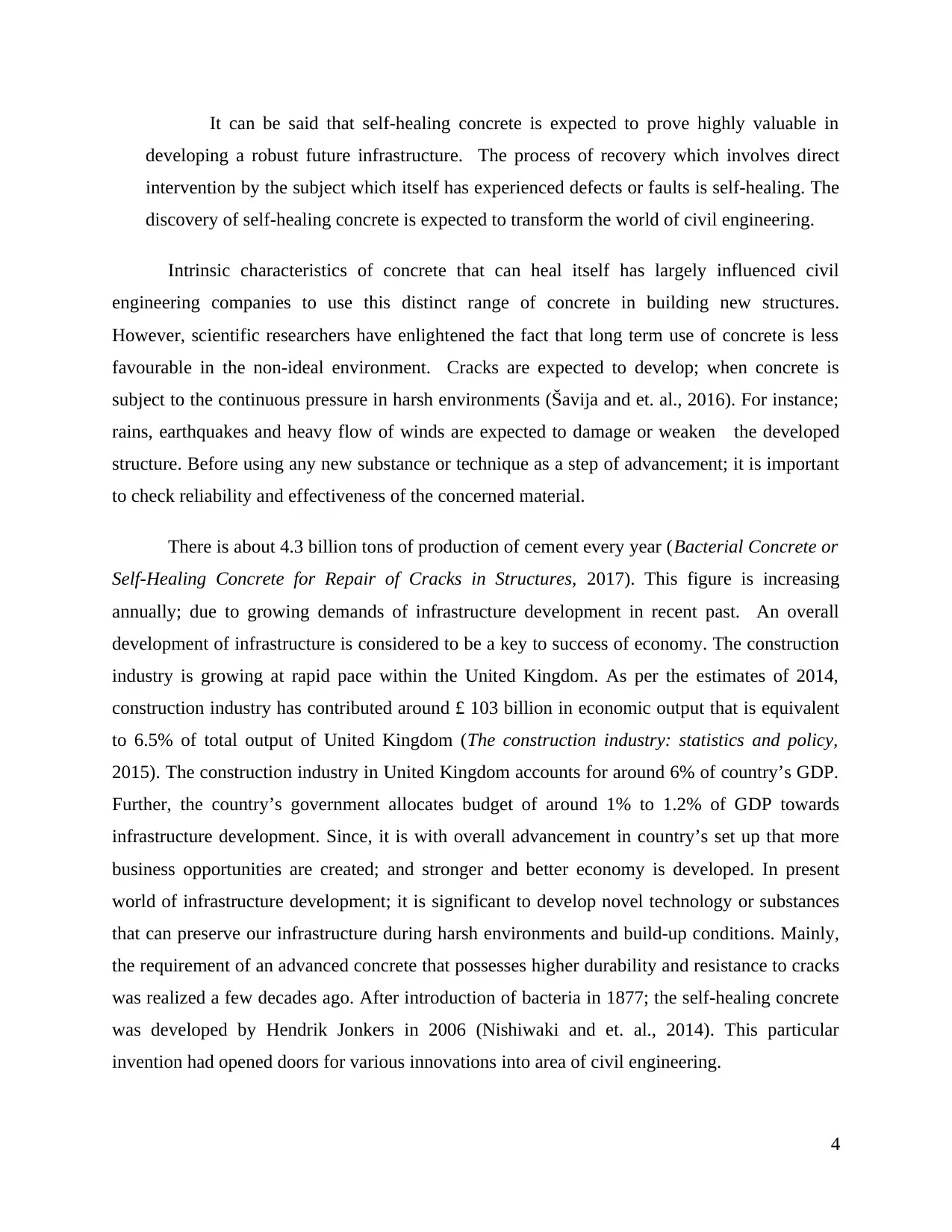
It can be said that self-healing concrete is expected to prove highly valuable in
developing a robust future infrastructure. The process of recovery which involves direct
intervention by the subject which itself has experienced defects or faults is self-healing. The
discovery of self-healing concrete is expected to transform the world of civil engineering.
Intrinsic characteristics of concrete that can heal itself has largely influenced civil
engineering companies to use this distinct range of concrete in building new structures.
However, scientific researchers have enlightened the fact that long term use of concrete is less
favourable in the non-ideal environment. Cracks are expected to develop; when concrete is
subject to the continuous pressure in harsh environments (Šavija and et. al., 2016). For instance;
rains, earthquakes and heavy flow of winds are expected to damage or weaken the developed
structure. Before using any new substance or technique as a step of advancement; it is important
to check reliability and effectiveness of the concerned material.
There is about 4.3 billion tons of production of cement every year (Bacterial Concrete or
Self-Healing Concrete for Repair of Cracks in Structures, 2017). This figure is increasing
annually; due to growing demands of infrastructure development in recent past. An overall
development of infrastructure is considered to be a key to success of economy. The construction
industry is growing at rapid pace within the United Kingdom. As per the estimates of 2014,
construction industry has contributed around £ 103 billion in economic output that is equivalent
to 6.5% of total output of United Kingdom (The construction industry: statistics and policy,
2015). The construction industry in United Kingdom accounts for around 6% of country’s GDP.
Further, the country’s government allocates budget of around 1% to 1.2% of GDP towards
infrastructure development. Since, it is with overall advancement in country’s set up that more
business opportunities are created; and stronger and better economy is developed. In present
world of infrastructure development; it is significant to develop novel technology or substances
that can preserve our infrastructure during harsh environments and build-up conditions. Mainly,
the requirement of an advanced concrete that possesses higher durability and resistance to cracks
was realized a few decades ago. After introduction of bacteria in 1877; the self-healing concrete
was developed by Hendrik Jonkers in 2006 (Nishiwaki and et. al., 2014). This particular
invention had opened doors for various innovations into area of civil engineering.
4
developing a robust future infrastructure. The process of recovery which involves direct
intervention by the subject which itself has experienced defects or faults is self-healing. The
discovery of self-healing concrete is expected to transform the world of civil engineering.
Intrinsic characteristics of concrete that can heal itself has largely influenced civil
engineering companies to use this distinct range of concrete in building new structures.
However, scientific researchers have enlightened the fact that long term use of concrete is less
favourable in the non-ideal environment. Cracks are expected to develop; when concrete is
subject to the continuous pressure in harsh environments (Šavija and et. al., 2016). For instance;
rains, earthquakes and heavy flow of winds are expected to damage or weaken the developed
structure. Before using any new substance or technique as a step of advancement; it is important
to check reliability and effectiveness of the concerned material.
There is about 4.3 billion tons of production of cement every year (Bacterial Concrete or
Self-Healing Concrete for Repair of Cracks in Structures, 2017). This figure is increasing
annually; due to growing demands of infrastructure development in recent past. An overall
development of infrastructure is considered to be a key to success of economy. The construction
industry is growing at rapid pace within the United Kingdom. As per the estimates of 2014,
construction industry has contributed around £ 103 billion in economic output that is equivalent
to 6.5% of total output of United Kingdom (The construction industry: statistics and policy,
2015). The construction industry in United Kingdom accounts for around 6% of country’s GDP.
Further, the country’s government allocates budget of around 1% to 1.2% of GDP towards
infrastructure development. Since, it is with overall advancement in country’s set up that more
business opportunities are created; and stronger and better economy is developed. In present
world of infrastructure development; it is significant to develop novel technology or substances
that can preserve our infrastructure during harsh environments and build-up conditions. Mainly,
the requirement of an advanced concrete that possesses higher durability and resistance to cracks
was realized a few decades ago. After introduction of bacteria in 1877; the self-healing concrete
was developed by Hendrik Jonkers in 2006 (Nishiwaki and et. al., 2014). This particular
invention had opened doors for various innovations into area of civil engineering.
4
⊘ This is a preview!⊘
Do you want full access?
Subscribe today to unlock all pages.

Trusted by 1+ million students worldwide
1 out of 62
Related Documents
Your All-in-One AI-Powered Toolkit for Academic Success.
+13062052269
info@desklib.com
Available 24*7 on WhatsApp / Email
![[object Object]](/_next/static/media/star-bottom.7253800d.svg)
Unlock your academic potential
Copyright © 2020–2025 A2Z Services. All Rights Reserved. Developed and managed by ZUCOL.





